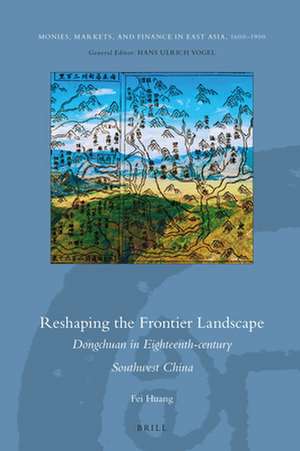Reshaping the Frontier Landscape: Dongchuan in Eighteenth-century Southwest China: Monies, Markets, and Finance in East Asia, 1600-1900, cartea 10
Autor Fei HUANGen Limba Engleză Hardback – 4 apr 2018
Preț: 504.49 lei
Preț vechi: 593.52 lei
-15% Nou
Puncte Express: 757
Preț estimativ în valută:
96.53€ • 101.06$ • 79.88£
96.53€ • 101.06$ • 79.88£
Carte indisponibilă temporar
Doresc să fiu notificat când acest titlu va fi disponibil:
Se trimite...
Preluare comenzi: 021 569.72.76
Specificații
ISBN-13: 9789004362291
ISBN-10: 9004362290
Pagini: 226
Dimensiuni: 155 x 235 x 25 mm
Greutate: 0.45 kg
Editura: Brill
Colecția Brill
Seria Monies, Markets, and Finance in East Asia, 1600-1900
ISBN-10: 9004362290
Pagini: 226
Dimensiuni: 155 x 235 x 25 mm
Greutate: 0.45 kg
Editura: Brill
Colecția Brill
Seria Monies, Markets, and Finance in East Asia, 1600-1900
Cuprins
Abbreviations
List of Illustrations
List of Tables
Acknowledgements
Introduction: Landscape and the Imperial Frontier
Dongchuan and Northeastern Yunnan
A Landscape Studies Approach
Landscape in the Empire’s Frontier
The Sources
Procedure
1 Paving the Way
Mountain and Road
Inside and Outside of the River
The Jinsha River and the Copper Transports
Conclusion
2 Valley and Mountain
Moving from the Mountains into the Bazi
1700–1730s War: Completing the Bazi
Spatial Network of the Copper Business
Newcomers, Indigenous People and Landscape Transformation
Conclusion
3 The Walled City
The Indigenous Strongholds on the Huize Bazi
Building the Stone-Walled City
Top-Down or Bottom-Up?
The Planning of an Ideal Civilized Walled City
Conclusion
4 Ten Views
The Scenic View Tradition
Sightseeing, the New Gazetteer and the Ten Views
The Ten Views and the Conventional Format
The Ten Views, Local Geography and the Copper Transportation
Conclusion
5 Zhenwu Shrine and Dragon Pool
The Mountain, the Temple and the Shrine
Replacing the Dragon Cult
Praying, Entertaining and Remembering
Conclusion
6 Two Wenchang Temples
Scholastic Good Fortune?
Relocating to Auspicious Sites?
“Huayizhai” or “Wanizhai”?
Preventing Water Disasters
Contesting Space between the Han and the Indigenous People
Conclusion
7 Ancestors, Chieftains and Indigenous Women
The Meng Yan Shrine: An Indigenous General Who Surrendered
Shesai and the Origin of the Lu Surname
“Fake” Han Chinese People or “Fake” Indigenous People
Conclusion
8 The New Mansions
Huiguan Associations in Frontier
Building the Huiguan
Conclusion
Conclusion
Bibliography
List of Illustrations
List of Tables
Acknowledgements
Introduction: Landscape and the Imperial Frontier
Dongchuan and Northeastern Yunnan
A Landscape Studies Approach
Landscape in the Empire’s Frontier
The Sources
Procedure
1 Paving the Way
Mountain and Road
Inside and Outside of the River
The Jinsha River and the Copper Transports
Conclusion
2 Valley and Mountain
Moving from the Mountains into the Bazi
1700–1730s War: Completing the Bazi
Spatial Network of the Copper Business
Newcomers, Indigenous People and Landscape Transformation
Conclusion
3 The Walled City
The Indigenous Strongholds on the Huize Bazi
Building the Stone-Walled City
Top-Down or Bottom-Up?
The Planning of an Ideal Civilized Walled City
Conclusion
4 Ten Views
The Scenic View Tradition
Sightseeing, the New Gazetteer and the Ten Views
The Ten Views and the Conventional Format
The Ten Views, Local Geography and the Copper Transportation
Conclusion
5 Zhenwu Shrine and Dragon Pool
The Mountain, the Temple and the Shrine
Replacing the Dragon Cult
Praying, Entertaining and Remembering
Conclusion
6 Two Wenchang Temples
Scholastic Good Fortune?
Relocating to Auspicious Sites?
“Huayizhai” or “Wanizhai”?
Preventing Water Disasters
Contesting Space between the Han and the Indigenous People
Conclusion
7 Ancestors, Chieftains and Indigenous Women
The Meng Yan Shrine: An Indigenous General Who Surrendered
Shesai and the Origin of the Lu Surname
“Fake” Han Chinese People or “Fake” Indigenous People
Conclusion
8 The New Mansions
Huiguan Associations in Frontier
Building the Huiguan
Conclusion
Conclusion
Bibliography
Notă biografică
Fei HUANG, Ph.D. (2012, Leiden University), is junior professor of Chinese Studies at the University of Tübingen, Germany. She has published articles on Chinese history in New History Journal, Late Imperial China, and Journal of Asian History.









